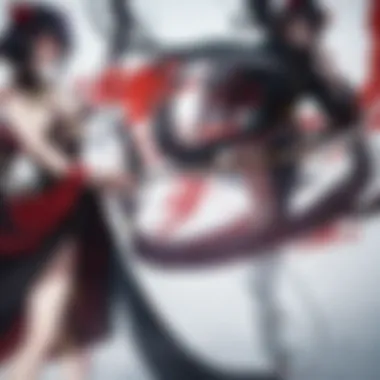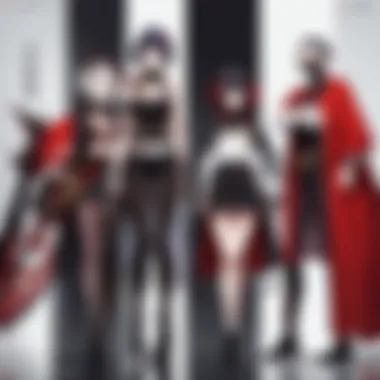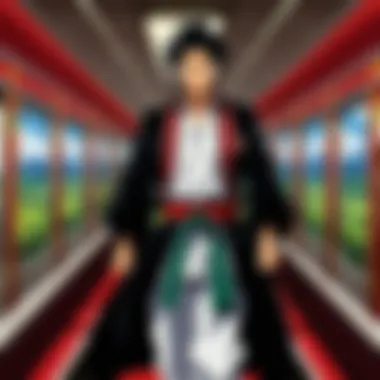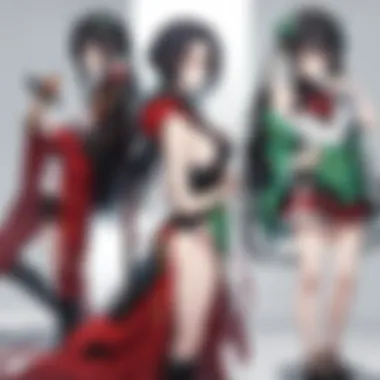Cultural Impact of Demon Slayer: Mugen Train


Intro
The immense popularity of Demon Slayer: Mugen Train goes beyond spectacular animation and gripping storylines. This film has carved a unique niche in the anime landscape, capturing the hearts of fans in Japan and around the world. It is not merely a continuity of a series, but a cultural phenomenon that has significantly influenced both anime production and film consumption. Analyzing its character development, narrative structure, and the thematic elements that resonate with audiences unearths the reasons behind its staggering success.
As we dissect various segments throughout this article, readers will get an in-depth view of how Mugen Train reshapes narratives within anime and cinema, exploring everything from the intricate character arcs to the broader cultural ramifications. This phenomenon offers a treasure trove of discussions for enthusiasts. Whether you're a die-hard fan or a casual viewer, the allure of this film is undeniable and warrants thoughtful examination.
The exploration will cover key aspects, including episode analyses, character spotlights, and comparisons of the original manga, with insight into the industry trends that accompanied the film's release. Additionally, we will take a glimpse into future developments of the Demon Slayer franchise, examining how it intends to sustain its momentum in a competitive market. The journey through this article aims to illuminate the intricate details that contribute to the success of Mugen Train while also acknowledging its monumental impact on global anime culture.
Preface to Demon Slayer
Understanding the phenomenon of "Demon Slayer" is not just about appreciating a popular anime or gripping narrative; it’s about grasping how a single work can resonate across cultures and generations. This introduction sets the stage for a thorough exploration of the franchise, emphasizing its roots, themes, and the fervor it has sparked among fans and casual viewers alike.
Overview of the Franchise
The franchise began with Koyoharu Gotouge’s Demon Slayer: Kimetsu no Yaiba, a manga that first graced the pages of Weekly Shōnen Jump in 2016. Within a short span, it transcended its publication origins, morphing into an anime adaptation produced by Ufotable that aired in 2019. The narrative follows Tanjiro Kamado, a young boy turned demon slayer after a fateful night where his family falls victim to a demon's attack.
The critical elements that contribute to the franchise's success include its vibrant animation, well-constructed character arcs, and a richly developed world that fuses traditional folklore with unique storytelling. The plot doesn’t just follow a hero’s journey; it intricately weaves themes of family, sacrifice, and resilience, striking a chord with many viewers.
Moreover, the franchise’s expansion into films, merchandise, and a diverse range of adaptations showcases its widespread appeal. Mugen Train, a film that directly follows the anime’s series plot, has cemented its position not just as a continuation of the story but rather as a landmark in cinematic achievement within the anime realm.
Rise in Popularity
When Demon Slayer hit the screens, it propelled into the limelight, becoming a cultural sensation. Several factors contributed to this meteoric rise. First and foremost, the adaptation by Ufotable was nothing short of stunning, making its visually captivating sequences the talk of both anime connoisseurs and the general public.
The show’s rich emotional depth and character development resonate widely; it’s not merely about slaying demons but exploring the complex psyches of each character involved. The struggle of the protagonists reflects universal themes that many relate to, making it harder for audiences to dismiss it merely as an action anime.
Additionally, the success of Mugen Train, which became the highest-grossing anime film of all time, further fueled its popularity. The film provided fans with closure and excitement, connecting them to the ongoing adventures of Tanjiro and his companions. Variety in merchandise, such as figures and clothing, along with social media discussions, propelled its presence within pop culture to unprecedented heights.
"Demon Slayer not only entertains but also provides viewers with profound reflections of their own struggles through its characters, a rarity in the modern anime landscape."
All these elements—stunning visuals, deep storytelling, and an engaging community—serve to elevate Demon Slayer from just another anime series to a significant cultural phenomenon, one whose impact continues to reverberate globally.
Mugen Train: A Synopsis
In the realm of anime, Demon Slayer: Mugen Train stands out not just as a continuation of a beloved franchise but also as a pivotal moment that reshaped how anime is consumed and appreciated globally. Understanding the plot and characters of Mugen Train provides valuable insight into its narrative depth and character dynamics, which have resonated with audiences far and wide.
Plot and Characters
Mugen Train picks up where the first season of Demon Slayer: Kimetsu no Yaiba left off, bringing viewers back into the world of Tanjiro Kamado as he, along with his loyal companions Zenitsu Agatsuma and Inosuke Hashibira, boards the infamous Mugen Train. The film revolves around their mission to assist the Flame Hashira, Kyojuro Rengoku, in combating a demon responsible for the mysterious disappearances of passengers aboard the train.
The plot intricately weaves action-packed sequences with a heartfelt exploration of character backstories. Tanjiro’s unyielding resolve to save everyone is expertly contrasted with the emotional turmoil faced by the other characters. Rengoku, as the Flame Hashira, embodies the spirit of sacrifice, showcasing the heavy burden of a warrior's duty. His charisma and strength not only inspire those around him but also create a lasting impact that challenges the ideals of bravery and legacy within the story.
Moreover, the film brilliantly delves into the tragic lives of its antagonists. Muzan Kibutsuji's wicked influence extends, casting shadows over the heroes who face deep-seated fears and regrets. It is this duality—of the heroes battling not just external demons but their inner darkness—that invites viewers to reflect on their moral compasses and the fight for hope amid despair.
Significant Themes
Mugen Train doesn’t shy away from profound themes, making it more than just an action flick. It explores concepts of loss, the weight of responsibility, and the quest for redemption. For instance, one of the striking themes is the idea of confronting one’s past. Throughout their battle on the train, characters grapple with their past experiences, revealing how these moments shape their identities and drive their actions.


- Sacrifice and Duty: Rengoku's journey highlights the essence of sacrifice, emphasizing that true strength often comes from willingness to lay down one’s life for others.
- The Nature of Dreams: The dream sequences in Mugen Train serve as a metaphor for desires and regrets, shedding light on what the characters truly yearn for, even if they seem unattainable.
- Friendship and Bonds: The camaraderie among Tanjiro, Zenitsu, and Inosuke shines, illustrating how collective strength can overcome overwhelming odds. Their dynamics add a layer of humanity to the otherwise grim narrative.
"The journey within Mugen Train embodies not just a physical battle against demons, but also a fight against the fears and memories that haunt us."
Mugen Train serves as a meticulously crafted narrative that balances heart-pounding action with profound thematic elements. This blend of character-driven storytelling and emotional resonance contributes to its status as a cultural phenomenon in the anime world, leaving a lasting legacy that transcends the screen.
Character Analysis
Understanding the characters in Demon Slayer: Mugen Train is essential to grasp the emotional depth and narrative drive of the series. Each character, from the noble Tanjiro to the fiery Rengoku, embodies distinct traits that resonate with viewers. Through character analysis, fans can appreciate the complexities of their motivations, conflicts, and growth throughout the story.
This analysis serves to uncover the layers behind the simplistic notions of good vs. evil, which often prevail in narratives like this. By dissecting the personalities and journeys of key figures, one gains insight not just into their actions, but also into the thematic nuances and cultural commentary interwoven within the narrative.
Let’s dive deeper into the characters who anchor this poignant tale.
Tanjiro Kamado: The Protagonist's Journey
Tanjiro Kamado embodies resilience and altruism, serving as a beacon of hope amid despair. His journey begins with tragedy, losing his family to demons, and the burden of his survival weighs heavily on him. Tanjiro’s unwavering resolve to save his sister Nezuko, who has been transformed into a demon, distinguishes him from other protagonists in the genre.
- Key Characteristics:
- Empathy: Tanjiro's ability to understand and show compassion even to demons reveals a profound moral framework.
- Growth: Throughout the series, he evolves from a novice fighter to a skilled Demon Slayer, learning to harness his abilities while facing intense emotional challenges.
Tanjiro's tenacity and emotional intelligence make him relatable to audiences, inviting them to share in his quest for redemption and the eradication of evil without losing sight of humanity. His character is a reflection of the struggle to balance strength with kindness in a brutal world.
Rengoku Kyojuro: The Flame Hashira's Legacy
Rengoku Kyojuro stands out as a fierce and passionate warrior. His larger-than-life persona and dedication to the Demon Slayer Corps reveal an unwavering commitment that inspires those around him. He represents the ideal of self-sacrifice and valor, becoming a moral compass for Tanjiro and his companions.
- Legacy and Influence:
- Heroic Archetype: Rengoku embodies the archetype of the traditional hero, whose flame-like spirit kindles courage in others.
- Personal Sacrifice: His final stand against powerful foes showcases the essence of sacrifice for a greater cause, leaving a lasting impression on viewers.
Rengoku’s character serves not only as a driving force within the plot but also symbolizes the ideals of courage and honor, inviting both reflection and admiration from the audience.
Antagonists and Their Motivations
The portrayals of antagonists in Mugen Train are far from typical. Unlike straightforward villains, they embody a range of emotions and narratives that provoke thought and reflection. Their motivations, steeped in personal histories and traumas, turn the narrative into a rich tapestry of conflict and exploration.
- Complexity of Antagonists:
- Depth of Emotion: Villains like Akaza present a multifaceted perspective, enhancing the moral ambiguity of the battle between demons and slayers. Their motivations often stem from tragedy or despair, challenging viewers to reflect on the nature of good and evil.
- Catalysts for Growth: These characters act as significant challenges for Tanjiro and his comrades, pushing them to confront their fears and evolve.
"The true enemy lies not just in external forces, but within ourselves and the choices we make."
Understanding these antagonists enriches the overall narrative, inviting the audience to reconsider the implications of morality, choice, and consequence within the broader context of the series.
Narrative Structure and Artistic Style


The narrative structure and artistic style of Demon Slayer: Mugen Train are pivotal in shaping its identity and resonating with audiences. They are like the backbone and skin of the storytelling body, intertwining the emotional journeys of characters with a vivid visual language. By examining these elements, we not only uncover how the film captures the hearts of its viewers but also gain insights into its broader impact on anime and film industries.
Cinematography and Animation Techniques
Examining the cinematography and animation reveals how Mugen Train sets itself apart in a crowded field. The scene composition, with its meticulous care, develops a sense of depth and immersion. For instance, the use of contrasting colors not only depicts the bleak realities faced by the characters but also accentuates their internal struggles. Each frame flows like poetry, striking a balance between action-packed sequences and quieter, more introspective moments.
A particular standout is the portrayal of Breath Techniques, where the animation bursts to life, creating a dance of fire and water, echoing the characters' emotional arcs. The fluid motion of the characters during combat scenes showcases a combination of traditional techniques and advanced CGI, bringing a fresh perspective to anime action choreography. This technique invites viewers to not just watch but feel embedded within this world, making the experience profoundly visceral.
Moreover, the film capitalizes on dynamic camera angles which zoom in and out to emphasize crucial moments in fight scenes, enhancing the suspense and drama. Such decisions in cinematography not only serve narrative purposes but also craft a rich tapestry for viewers to be part of.
Soundtrack and Emotional Resonance
The soundtrack of Mugen Train plays a dual role: it complements the visuals while standing alone as a work of art. Composed by Yuki Kajiura and Go Shiina, the score evokes a spectrum of emotions — from the exhilarating rush during battle scenes to tender, heartwarming moments that tug at the heartstrings. Music here isn't just background noise; it is the unseen character that interacts with pivotal scenes, further enhancing their emotional weight.
Take, for example, the track "Homura" performed by LiSA. This song resonates deeply beyond the screen, encapsulating the film's themes of loss and hope. Its somber yet uplifting melody strikes a chord with audiences, serving as an anthem for the characters' struggles.
The sound design— a blend of traditional Japanese instruments and modern orchestrations— elevates the narrative, giving it a richer cultural context. This fusion mirrors the film's own themes of tradition vs. modernity, a reflection of Japan's contemporary society, making it relatable to a global audience.
"The music in Mugen Train does not merely accompany the visuals; it weaves them together, intensifying the emotional gravity of each scene."
Audience Reception and Critical Acclaim
Understanding how an audience receives a piece of work, especially in the realm of anime, serves as a barometer for its impact and significance. In the dynamic world of film and media, Demon Slayer: Mugen Train stands out not just for its animation quality and storytelling but also for the strong emotional resonance it has built with viewers globally. The audience's response plays a pivotal role in determining the legacy left behind by such titles. Analyzing its reception offers insights into why it has connected with such a broad spectrum of fans and how it influenced the anime landscape.
Box Office Success
Mugen Train has shattered numerous previous records, establishing itself as a titan at the box office. This is evident in how it became the highest-grossing anime film globally, surpassing even the likes of Spirited Away. Some key factors contribute to this astonishing success:
- The franchise's existing popularity: The strong fanbase formed from the Demon Slayer series laid a solid groundwork.
- Unique storytelling: The narrative built suspense, providing a fresh take on traditional shonen elements.
- Engaging characters: Relatable and well-developed characters drew viewers in, making them eager to see their journey unfold on the big screen.
Despite challenges like pandemic-related theater closures, Mugen Train's ability to draw audiences was nothing short of impressive. It showcased that audiences were not merely looking for entertainment, but for an experience that engaged them on multiple emotional levels.
Critical Reviews and Fan Reactions
Critical reception for Mugen Train has been overwhelmingly positive, which speaks volumes in a genre often riddled with skepticism. Notably, the film has garnered praise from both mainstream critics and fans alike. Its multifaceted approach to storytelling and production values has resonated with many.
"Demon Slayer: Mugen Train is not just a film but an experience that lingers, making us reflect on loss, resilience, and the bonds of family."
The reviews highlighted various elements:
- Cinematic Quality: The animation quality was called "breathtaking," pushing the boundaries of what could be expected in anime.
- Emotional Depth: Critics noted how the film effectively interwove themes of grief, sacrifice, and camaraderie, leaving many viewers moved to tears.
On the fan side, reactions poured in through social media platforms like Reddit and Facebook. The film not only sparked discussions about favorite characters but also provoked thoughtful conversations about its themes. Fans often shared artwork, memes, and fan theories, further cementing the film's place in popular culture. This organic engagement showed that viewers felt personally connected to the story and characters, enhancing the overall impact of Mugen Train.
In summary, by examining the profound box office success and critical acclaim, it's clear that Demon Slayer: Mugen Train has resonated with a diverse audience. Its success is not merely numerical; it mirrors a cultural phenomenon that blends storytelling with emotional engagement.
Cultural Impact of Mugen Train


The cultural influence of Demon Slayer: Mugen Train is vast and multifaceted, making it a pivotal entry in the realm of anime cinema. It not only attracted a broad audience but also reshaped industry standards and audience expectations. By appealing to both seasoned anime fans and newcomers alike, this film bridges generational gaps, fostering a deeper appreciation for the art form.
Influence on Anime and Film Trends
Mugen Train combined cutting-edge animation with a compelling narrative, marking a significant turning point in how anime films are perceived both in Japan and internationally. It demonstrated that animated films could achieve blockbuster status alongside traditional live-action offerings. After its release, many studios began to rethink their approach to filmmaking and distribution, realizing that investing in high-quality animation could yield remarkable returns at the box office.
The film's success fueled a number of trends in anime and cinema:
- Increased Production Quality: Following the remarkable visuals of Mugen Train, other studios started to allocate more resources towards animation techniques and production values. Projects that previously might have received a modest budget now often aim for grander visual spectacles.
- Theatrical Releases: Prior to Mugen Train, anime films typically enjoyed a limited engagement in theaters. However, its unprecedented box office performance encouraged more anime titles to opt for wider theatrical releases, thus expanding their audience base.
- Integration of Streaming Services: As audiences shifted, streaming platforms started to license anime films for exclusive releases, transforming the landscape of how film is consumed. This made it easier for global audiences to access anime content more readily.
Demon Slayer not only holds a mirror up to the evolving anime landscape but also acts as a compass pointing toward future directions in anime filmmaking.
Merchandising and Market Trends
The merchandising aspect of Mugen Train showcases a business model that capitalizes on the film's popularity. It opened doors to a new wave of merchandise that appealed to a broad array of demographics, from hardcore fans to casual viewers.
A few notable trends include:
- Diverse Product Range: The film's branding led to a sprawling range of merchandise, including action figures, apparel, and collectibles. For example, characters like Rengoku Kyojuro found themselves on everything from plush toys to limited-edition art prints. This diversification helped cultivate a culture of fandom that went beyond the screen.
- Collaborations and Partnerships: Many brands jumped on the Mugen Train bandwagon, partnering for co-branded products. This includes themed cafes, limited-time offers, and exclusive merchandise for collectors. Such collaborations often attracted new customers who may not be well-versed in anime.
- Impact on Sales Data: Economic reports from greedy-eyed analysts indicated that certain merchandise related to Mugen Train significantly boosted sales for various companies in a saturated market, creating ripples of financial success that many industry players couldn't ignore.
In summary, the cultural impact of Demon Slayer: Mugen Train extends far beyond its cinematic achievements. It is a catalyst for change in the anime industry and beyond, shaping trends that will influence the future of animated storytelling and merchandising in profound ways.
Future of the Demon Slayer Franchise
The future of the Demon Slayer franchise holds significant implications for both its creators and fans alike. Given the astronomical success of Mugen Train, discussions surrounding future projects, spin-offs, and expansions have become increasingly relevant. Understanding what lies ahead gives insight into how the franchise will continue to evolve and maintain its global impact. The franchise has already transformed the anime landscape, and its future projects could either solidify that status or present new challenges in a saturated market.
One specific element to consider is the potential for broadening the narrative universe through spin-offs. This expands character arcs and allows a deeper dive into less explored figures in the series. Given the popularity of characters like Rengoku Kyojuro, audiences are undoubtedly eager to see more of their backstories and adventures. By creating additional content, the franchise can sustain interest while ensuring that it resonates with both new viewers and long-time fans.
Additionally, the artwork and animation styles that have come to symbolize Demon Slayer remain a focal point. These aspects serve as both a promotional tool and a narrative device. Therefore, any upcoming projects will need to adhere to the high standards that audiences have come to expect. However, trying something different could also invite fresh perspectives and interpretations of the source material.
"The strength of a franchise often relies on its ability to innovate while also honoring its roots."
Considerations regarding merchandising are also vital in evaluating the franchise's trajectory. Limited edition collectibles, apparel, and partnered products could skyrocket in sales if connected effectively to new storylines. This not only enhances fan engagement but serves as a revenue stream that can support animation projects or expansions. Understanding how to capitalize on these market trends will be crucial as the franchise releases more content.
While there are myriad paths available for the future of the Demon Slayer franchise, each project must strive for balance. Retaining the heart of the story while exploring new avenues will be key for ongoing success. The anticipation surrounding upcoming projects invites a mix of excitement and scrutiny, leaving both fans and creators at a crossroads of possibility and expectation.
Upcoming Projects and Spin-offs
In the realm of upcoming projects, there's considerable buzz about a new installment that could act as a direct follow-up to the events of Mugen Train. While official announcements remain scant, various teasers have pointed toward a continuation of Tanjiro's journey as he faces evolving demons and inner conflicts. Possible adaptations of the subsequent arcs in the manga could be on the horizon, paving the way for new heroes and rivalries.
Additionally, rumors about potential spin-offs are swirling, especially regarding fan-favorite characters such as Zenitsu Agatsuma and Nezuko Kamado. Wouldn't it be fascinating to delve deeper into Zenitsu's backstory, examining the facets of his character that often get overshadowed by his louder companions?
- Possible projects may include:
- A series focusing on the Hashira and their individual battles against demons.
- A deeper exploration into the lives of the Twelve Kizuki before coming face to face with the Demon Slayer Corps.
These potential projects allow the franchise to maintain its momentum while catering to the diverse interests of its fan base.
Concluding Thoughts
As the future unfolds for the Demon Slayer franchise, it presents both opportunities and challenges that could redefine its cultural footprint. The ongoing battle between innovation and nostalgia will shape the direction of new projects. It is crucial for creators to remain attuned to fan feedback and the broader trends in anime and cinema. This attentiveness ensures that upcoming content resonates on a global scale, captivating audiences both old and new.
As this vibrant franchise continues to grow, fans hold their breath in hope and anticipation, ready to embrace each twist and turn. Will the new projects deliver the same emotional depth and intricate storytelling? Only time will tell, but for now, the stage is set for exciting developments on the horizon.
With its rich narrative potential and vibrant characters, the story of Demon Slayer is far from over, and its impact on the anime landscape is poised to endure.







